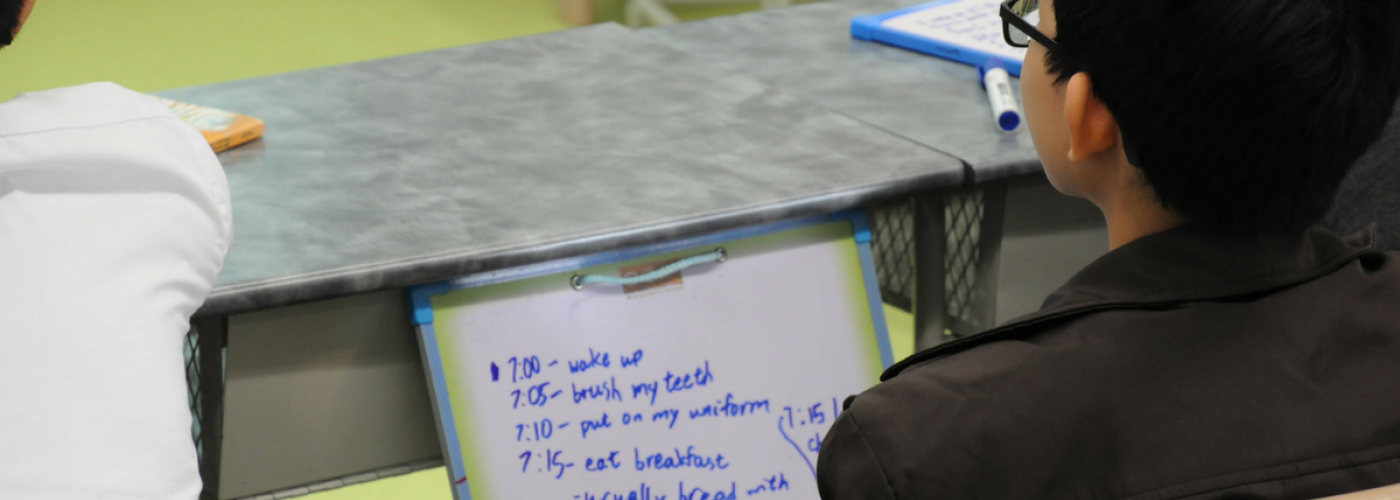28th November 2017
The language that we use with our students, and the language that they use with each other at different points of a lesson, is fundamental to English language education. This article aims to outline some of the features of the interaction which happens in language classrooms in order to find ways that we can maximise the quality of communication that happens between teachers and students.
When we are planning to teach a certain language point, we typically focus on the types of word, sentence or dialogue that we will ask our students to produce in a lesson. This task-based language is very important to consider, but how much do you think about the interaction that happens around these task-based stages? The ways that a teacher uses language during less structured parts of a lesson, for example while correcting errors, taking feedback from a task or helping a student to brainstorm ideas, can be planned for the benefit of the wider experience that learners have during lesson time.
Let’s define some important features of classroom discourse and think about some ways these events can be optimised for learning, even when students are not working on specific language tasks:
Teacher questions
In a communicative, student-centred classroom, a large proportion of teacher talk is taken up by questions. The more the teacher asks, the more student response is made possible, and therefore the more evidence we can get about how much our students are getting from our lessons.
Open and closed questions
A good example of the effect of different questions on interaction is the types of response that we can expect from open questions (where there are multiple possible answers) and closed questions (where the answer is a simple ‘yes’ or ‘no’). Compare the possible response to the following teacher questions:
‘Do you like watching movies?’
versus
‘What kind of movies do you like?’
Obviously, the second question will prompt a much fuller and more varied set of responses, and would provide evidence of different students’ range of vocabulary, and their ability to state preferences. Now think about open and closed questions used to prompt for the answers to a true or false reading task, for example. What types of student response might be prompted by the following post-task feedback questions:
‘So number 1; do you think it’s true or false?’
versus
‘How did you find your answer for number 1?’
Again, the open question would elicit a much more thoughtful response, and therefore give much more evidence of how the student was processing the reading task.
Display questions and real questions
Many of the questions that teachers ask their classes are not ‘real’, i.e. the teacher already knows the answer and is expecting a specific response. These are known as ‘display’ questions, and although they are very valuable in controlled stages of a lesson, such as during a presentation of vocabulary or grammar, display questions can significantly restrict the amount of real communication that we might want to happen later in a lesson.
Think of stages in your lesson when you want controlled, managed interaction (possibly in accuracy-focused activity), and when you want to stimulate more fluency. Plan real questions for more authentic interaction, and display questions for specific language instruction.
High-cognitive and low-cognitive talk
Another way of seeing classroom discourse is by thinking about the cognitive level of activity that is stimulated by your language and the students’ responses. Research shows that in any classroom, the cognitive level of student talk closely mirrors that of teacher talk. This means that the more evaluative / critical / analytical your questions and ideas are, the more your students will probably analyse, evaluate and reflect upon what they are doing. These are important skills in any educational setting, and more can be made of language education if students are in the habit of working in these higher-cognitive ways.
Think about the following question headers and put them on order according to how much and what kind of student response might be elicited form them:
What… (what is this? / what do you call…? / what do you do… / what kind of…)
How… (how do you… / how often do you… / how do you feel about… / how might you…)
Why… (why do people… / why did you… / why do you… / why don’t you…)
Where… (where do you… / where do people… / where did you…)
When… (when do you… / when do people… / when is it OK to…)
Who… (who does this? / who likes… / who did you…)
Just by doing a quick brainstorm of the questions and responses that happen in your classroom, you will probably find that responses to these questions range in complexity from naming and description (what / who / where / when: low-cognitive) through categorising and grouping (what kind... / when do people…: mid-cognitive) to evaluating, analysing, reflecting and applying criteria (how / why: high-cognitive). The questions you ask to your students can be planned and graded in this way at different points in a lesson to encourage different kinds of thinking at different times. Typically, activity in a language lesson moves from low (identifying and naming) through to high (analysing, reasoning and applying language patterns) as the lesson progresses. With attention to your own language as a teacher, this flow can be tailored for the requirements of the students according to the language you are teaching.
Student-student interaction and discourse
Finally, let’s consider some ways of increasing the quality of student to student communication during language lessons. It is a fundamental principle of communicative language teaching that the more students have the chance to meaningfully communicate with each other using the language they are learning, the greater the chance of that language being deeply acquired by the learners. It is therefore important to consider how and when students can get the most out of communication with their peers.
A good technique to maximise the quality and quantity of student talk is to set mini-tasks of about 2 minutes, where students have to quickly turn to their partner and discuss a question which is designed to take them to the next step of their development. Rather than directly presenting the words you are teaching one by one, or giving them a grammar point to use, shoot a quick low-cognitive question at the class to work with, then take their ideas back to the whiteboard for use during the lesson. In a vocabulary lesson, have students describe a picture containing key concepts, and let them work with what they know before you present new language. In grammar lessons, ask a focused functional question, the answer to which is naturally formed with the target grammar, and see if students can form that idea grammatically before you start presenting it directly. This will give you information about their existing knowledge and their specific needs in that area.
Example: We use the present perfect tense to talk about news that we have recently heard – that is one of the tense’s functions. Turn that into a brainstorming question, and see whether the students can apply language to that function appropriately, e.g.
‘Turn to your partner and tell them about something you heard about recently – a piece of news or an amazing thing that happened. Do this in 2 minutes. Go!’
When you stop the talk, ask students what they talked about, and board any good examples, using the grammar that the students use, whether correct or incorrect.
Highlight the forms that you have written up, and ask for correction where necessary, prompting that although these things happened in the past, they are still interesting to us now, in the present.
These two functional prompts (news, past events with present import) should be enough for any students who know the form to call it out, or for any who don’t to have a clear purpose for the grammar that is coming in the rest of the lesson, when you can continue into your presentation of language. Again, your choice of question or prompt, along with an instruction for students to talk together before reflecting on their ideas and adjusting their language accordingly, follows a good model of classroom discourse (low to high cognitive, student-centred and purposeful).
In summary, as language teachers, we should consider not just the language we are teaching, but the ways in which we expect our students to respond to our classroom talk. We can manipulate student through the features of our own talk, to elicit more appropriate responses for the benefit of both our teaching and the students’ learning. Start by planning out the questions you will ask at key stages of your lesson, and develop questioning routines that aim for achievable and relevant types of thinking, and you will indirectly instil some valuable communicative routines in your classroom.
Are you looking to brush up on your teaching skills? Check out our upcoming teacher training workshops here in Hong Kong.



